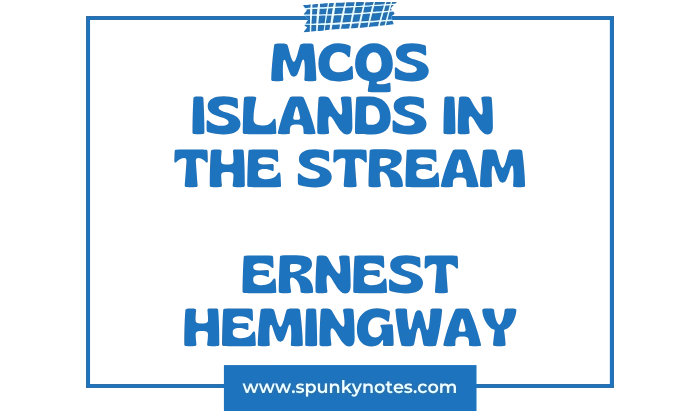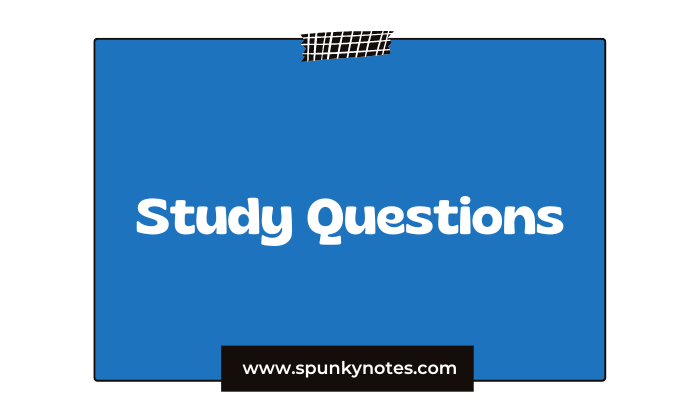
Islands in the Stream MCQs
1. Where is Thomas Hudson’s house built on Bimini?
A. Near the main marketplace
B. Between the harbor and the open sea
C. On the highest hill overlooking the port
D. Next to the casuarina trees
2. What is the primary danger to bathers off the beach at night?
A. Strong offshore currents
B. Barracuda attacks
C. Sharks coming close to shore
D. Sudden tropical squalls
3. What is Thomas Hudson’s profession?
A. A writer and boat captain
B. A dealer in antique furniture
C. A well-known painter
D. A retired military officer
4. What structural feature does the house possess that makes it comfortable during winter?
A. Heavy insulation
B. The only fireplace on the island
C. A deep, protected cellar
D. Cross-ventilation
5. How does Thomas Hudson primarily view and refer to his house?
A. A fortress
B. A safe harbor
C. Her, like a ship
D. His sanctuary
6. How did Thomas Hudson primarily handle his feelings of guilt and loneliness?
A. By socializing constantly
B. By leaving the island frequently
C. By replacing them with dedicated work
D. By studying philosophy
7. How long were the two younger boys scheduled to visit Thomas Hudson?
A. Four months
B. Five weeks
C. The entire summer
D. Until Christmas
8. What characteristic defines the mother of the two younger boys in making her plans?
A. Flexibility
B. Complete secrecy and rigidity
C. Open consultation
D. Frequent compromise
9. What physical characteristics mark the oldest boy, young Tom?
A. Fair hair and a muscular build
B. Dark, with long legs and a swimmer’s build
C. A quiet temperament and small stature
D. Red hair and a freckled face
10. Which animal does the middle boy, David, primarily resemble?
A. A sleek seal
B. A humorous otter
C. A protective bear
D. A quick deer
11. What skill is the youngest boy, Andrew, noted for?
A. Outstanding academic talent
B. Exceptional speed in running
C. Being an excellent athlete, good with horses
D. Great musical talent
12. What did young Tom’s mother give Thomas Hudson for Christmas instead of a shotgun?
A. A silver flask
B. A carving knife
C. A slingshot
D. A fishing reel
13. What famous literary figure did young Tom know when he was a baby in Paris?
A. F. Scott Fitzgerald
B. Ernest Hemingway
C. James Joyce
D. Gertrude Stein
14. What painful memory does Roger confess regarding his brother?
A. His brother was killed in the war
B. He failed to save his brother from drowning
C. His brother died of a childhood illness
D. He betrayed his brother during a fight
15. What item does the rude gentleman from the yacht return with after the bar fight?
A. A large hunting knife
B. A silver cane
C. A shotgun
D. A long piece of rope
16. What animal’s fin alerts the men to the great shark near David?
A. A whale shark’s tail
B. An observation plane
C. The hammerhead’s high triangular fin
D. A small porpoise
17. Who ultimately shoots the attacking hammerhead shark?
A. Thomas Hudson
B. David
C. Roger Davis
D. Eddy
18. What physical description of Audrey Bruce (Audrey Raeburn) reminds Thomas Hudson of Young Tom’s mother?
A. Her height and build
B. Her tawny hair and lovely legs
C. Her small upturning curls at the nape of her neck
D. Her eyes and the way she smiled
19. What physical sensation does Thomas Hudson relate the feeling of a double frozen daiquiri to?
A. The warmth of a fire
B. Downhill glacier skiing
C. The cold of deep water
D. A rapid heartbeat
20. What is the fate of Andrew and David, as revealed in the radio message?
A. They are injured at sea
B. They were killed in a motor accident
C. They were captured by enemy forces
D. They were lost while sailing
21. Where is the main setting of the second part of the novel, where Thomas Hudson lives and works?
A. Havana
B. New York
C. The farm (Finca) outside Havana
D. The Florida Keys
22. What is the name of Thomas Hudson’s primary black and white cat?
A. Willy
B. Goats
C. Princessa
D. Boise
23. What unique quality of Thomas Hudson’s perfect “princess” does he dream of?
A. She must be rich and politically influential
B. She must be an unfaithful woman
C. She must be grave and delicate, then wanton and shameless
D. She must be much older than him
24. What primary luxury ingredient does Thomas Hudson request in his Tom Collins?
A. Aged Caribbean rum
B. Fresh coconut water
C. Imported tonic water
D. Angostura bitters
25. What is the profession of young Tom’s mother (the first wife) during the Cuban section?
A. A professor
B. A USO employee
C. A war journalist
D. An actress
26. What does Thomas Hudson consider the main problem with the poor neighborhoods in Havana?
A. Political corruption
B. Crime and violence
C. Dirt, poverty, and general suffering
D. Lack of police protection
27. Who is the gentleman who proposes a political platform based on the “lack of an aqueduct”?
A. Henry Wood
B. Ignacio Natera Revello
C. The Alcalde Peor (Worse Mayor)
D. Fred Archer
28. What is Thomas Hudson’s reaction when Ignacio Natera Revello proposes a toast to his dead son, Tom?
A. He joins the toast immediately
B. He becomes quietly angry and curses the Latin phrase
C. He asks Ignacio to leave
D. He starts crying uncontrollably
29. What does Honest Lil confess she hates hearing men speak about?
A. Politics and money
B. Their wives and themselves were crying
C. Their failures in war
D. Drinking too much
30. What literary work does Thomas Hudson recall reading that made him feel sick inside, despite being far away?
A. Time magazine’s Milestones
B. Ulysses
C. Dante’s Inferno
D. The New Yorker
31. Thomas Hudson’s first wife says she loves him but is “in love” with whom?
A. Roger Davis
B. A general
C. A man who is nice, like children
D. A professional soldier
32. What specific object does Thomas Hudson ask his wife to save for the cats at the Finca?
A. Cooked fish
B. Canned milk
C. Raw eggs
D. Bananas
33. What is the fate of Young Tom, according to Thomas Hudson’s later conversation with his wife?
A. Died in a boating accident
B. Shot down in a Spitfire
C. Missing in action
D. Got killed
34. What does Thomas Hudson’s wife conclude about their relationship, despite their separation?
A. It was entirely based on conflict
B. They were both beautiful and always loved each other
C. They were rivals who could never be reconciled
D. It was purely a physical connection
35. What is the emotional state Thomas Hudson’s wife experiences immediately after learning about Tom’s death?
A. Violently weeping
B. Anger and bitterness
C. Shaking, trembling, and feeling hollow sick
D. Instant acceptance
36. What is the primary evidence that Thomas Hudson finds indicating the massacre victims were killed by the U-boat crew?
A. A German flag
B. 9mm Schmeisser machine pistol bullets
C. German-made uniforms
D. Enemy maps left behind
37. What type of weapon does Thomas Hudson use to shoot the large land crab?
A. A conventional hunting rifle
B. A .357 Magnum pistol
C. A fragmentation grenade
D. A flare gun
38. The dead German sailor found later on the beach was killed by whom?
A. Thomas Hudson’s crew
B. An American plane
C. A Spanish patrol
D. His own comrades
39. Ara defines the “pride without vanity” that the men possess as having what three elements?
A. Honor, discipline, and courage
B. Failure, shit, and death
C. Loyalty, strength, and love
D. Work, rest, and sobriety
40. What is Peters’ role aboard Thomas Hudson’s boat?
A. Cook
B. Radio operator
C. Engine mechanic
D. Helmsman
41. What is the ship’s position after Thomas Hudson changes course when he is abeam of a specific light?
A. Headed into the heavy sea
B. Headed home to pasture in the channel
C. Running toward the open sea
D. Running toward Havana
42. How does Willie describe his state of mind to Thomas Hudson?
A. Confident and fully functional
B. Suffering from constant nightmares
C. Half crázy, like Thomas Hudson
D. Ready to quit the mission
43. Who is the Basque crewman known for being physically strong and agile?
A. Ara
B. Willie
C. George
D. Gil
44. Why does Thomas Hudson take Peters along when going to board the turtle boat?
A. Peters is the best shot
B. He needs Peters to speak German to the enemy
C. Peters insisted on going
D. He wants to expose Peters to danger
45. How does Peters die on the turtle boat?
A. From the explosion of a grenade
B. Shot by Thomas Hudson accidentally
C. Shot by a wounded German sailor
D. Falling overboard and drowning
46. What type of improvised bomb does Gil throw with great accuracy?
A. A tin can filled with powder
B. A gasoline bottle
C. A dynamite-rigged fire extinguisher
D. A standard Naval shell
47. What does Willie and Ara do to the turtle boat to guarantee it sinks?
A. They fire multiple torpedoes at it
B. They shoot holes through the hull
C. They throw multiple grenades into the hatches
D. They chop it apart with a machete
48. After the turtle boat fight, what is revealed about the German escape party?
A. They had stolen a speedboat
B. They sank their skiff and fled by land
C. They were all killed, except one guide
D. They sank their skiff and cut the sail up
49. What is Thomas Hudson’s decision regarding the captured enemy position after the fighting stops?
A. To send Willie in alone for a reconnaissance
B. To continue pounding the key with firepower
C. To tow the turtle boat back to the ship
D. To leave the area and report to headquarters
50. What is Thomas Hudson’s final internal reflection before his wounds overcome him?
A. He hopes to see his wife again
B. He must survive to paint the sea
C. He regrets not taking the morphine earlier
D. He hopes the Germans suffer
Brief Overview
The novel by Ernest Hemingway is about the life of Thomas Hudson. He is a good painter who lives on an island called Bimini. His house is strong, built like a ship.
Thomas Hudson loves the island and its changing seasons. He works hard at his painting. He is happy because his three sons are coming to visit him for five weeks. The boys are young Tom, David, and Andrew.
The man loves his children greatly. He is happy just hearing them breathe at night. He tries to overcome past guilt and loneliness with work.
The boys arrive, bringing fun and breaking his habits of living alone. Thomas Hudson worries about his son, David, during an intense battle with a huge swordfish. David fights for hours but loses the great fish.
The novel then moves to Cuba, after Thomas Hudson receives shocking news. His sons, David and Andrew, were killed in a motor accident with their mother. A telegram tells him the news.
Later, Thomas Hudson goes to sea on his boat, hunting German U-boat survivors. During a gunfight in a narrow channel, he is severely wounded. He continues the pursuit but is near death. He reflects on his duty and losses in his final moments.

